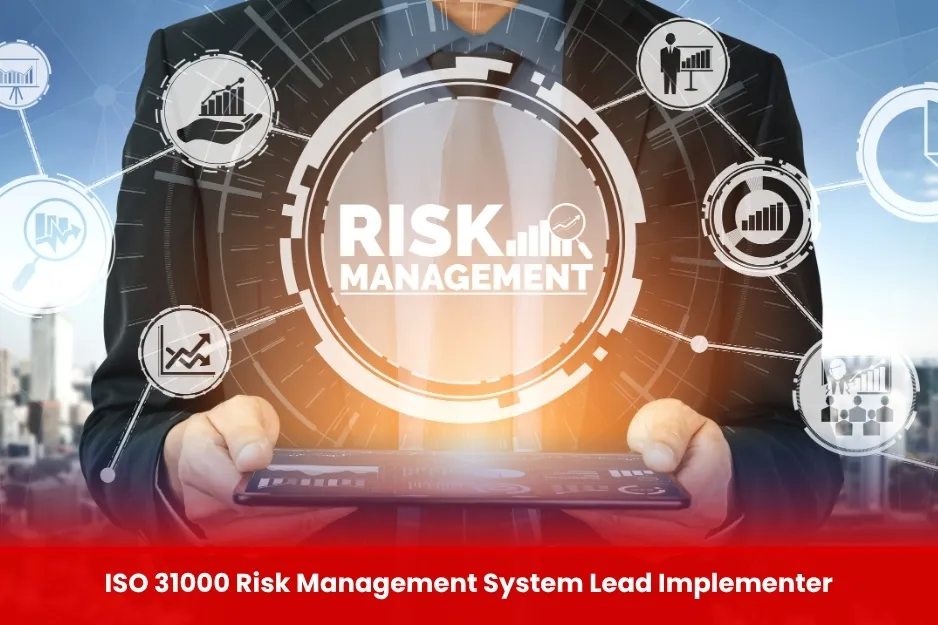ISO 31000 Risk Management System Lead Implementer
ISO 31000 is the international standard that provides principles, a framework, and a process for managing risk effectively. It helps organizations of all types and sizes identify, assess, and manage risks that could impact their objectives, operations, reputation, or stakeholders.
A Lead Implementer for ISO 31000 is a trained professional responsible for designing, developing, and leading the implementation of a risk management system based on the ISO 31000 standard. This role ensures that risk management is integrated into the organization’s governance, leadership, strategy, and culture.

Aim of ISO 31000 Risk Management System Lead Implementer
Equip professionals with the knowledge, skills, and leadership capabilities to design, implement, and manage a comprehensive Risk Management System based on ISO 31000, enabling organizations to proactively identify, assess, and control risks in alignment with their strategic objectives.
Course Overview
ISO 31000 Risk Management System Lead Implementer
Educational Qualification
- Bachelor’s degree or diploma in fields such as:
- Business Administration
- Risk Management
- Finance
- Engineering
- Law
- Management
- Environmental Science
- Or any related discipline
- Professional Experience
- 1–3 years of experience in any of the following roles:
- Risk management or enterprise risk
- Compliance or internal controls
- Governance and policy development
- Business continuity or crisis management
- Project or operations management
| Course Code | Curriculum Title | Credit | DLH |
|---|---|---|---|
| BUK1966-1 | Introduction to ISO 31000 and Risk Management Concepts | 3 | 15 |
| BUK1966-2 | Understanding the ISO 31000 Framework | 3 | 15 |
| BUK1966-3 | Establishing the Risk Management Framework | 3 | 15 |
| BUK1966-4 | Risk Identification and Assessment | 3 | 15 |
| BUK1966-5 | Risk Treatment and Response Planning | 3 | 15 |
| BUK1966-6 | Monitoring, Review, and Continual Improvement | 3 | 15 |
Module 1: Introduction to ISO 31000 and Risk Management Concepts
- Overview of ISO 31000:2018
- Importance of risk management in modern organizations
- Principles of effective risk management
- Definitions: risk, uncertainty, risk appetite, tolerance, etc.
Module 2: Understanding the ISO 31000 Framework
- The three pillars: Principles, Framework, Process
- Integration of risk management into governance and leadership
- Aligning risk with organizational strategy and objectives
Module 3: Establishing the Risk Management Framework
- Setting up risk management policy and objectives
- Roles and responsibilities of leadership and risk owners
- Building a risk-aware culture across the organization
- Communication and consultation strategy
Module 4: Risk Identification and Assessment
- Risk identification techniques (SWOT, PESTLE, checklists, etc.)
- Risk sources, events, and consequences
- Risk analysis: qualitative and quantitative methods
- Risk evaluation: comparing risk levels to criteria
Module 5: Risk Treatment and Response Planning
- Selecting and implementing appropriate risk treatment options
- Developing risk mitigation strategies
- Risk acceptance, avoidance, transfer, or reduction
- Preparing risk treatment plans and controls
- Selecting and implementing appropriate risk treatment options
- Developing risk mitigation strategies
- Risk acceptance, avoidance, transfer, or reduction
- Preparing risk treatment plans and controls
Module 6: Monitoring, Review, and Continual Improvement
- Ongoing risk monitoring techniques
- Internal audit of the risk management system
- Reviewing effectiveness of risk treatments
Module 7: Integrating Risk Management into Business Functions
- Embedding risk in key areas like:
- Project management
- Supply chain
- Finance and investments
- Compliance and legal
- Risk-based decision-making and performance management
Module 8: Lead Implementation Planning and Leadership
- Leading the risk management implementation team
- Change management and stakeholder engagement
- Overcoming resistance to risk processes
- Managing implementation timelines and resources
Module 9: Case Studies and Practical Exercises
- Real-life examples of successful risk frameworks
- Group exercises on identifying and evaluating risks
- Drafting risk registers and treatment plans
- Role-play: presenting a risk management framework to top management
- Risk Managers / Officers / Analysts
- Compliance and Legal Professionals
- Internal and External Auditors
- Business Continuity and Crisis Managers
- Health, Safety, and Environment (HSE) Professionals
- Quality and Management System Professionals
- Project and Program Managers
- Consultants and Advisors
- Executives and Department Heads
- All Modules within this qualification are assessed internally by the approved training Centre and externally verified by BURRAQ UK. The program uses a criterion-referenced assessment approach to ensure that learners successfully meet all required learning outcomes.
- A Pass in any unit is granted only when the learner submits valid, reliable, and authentic evidence that demonstrates achievement of the assessment criteria. The Assessor is responsible for reviewing this evidence and confirming that the learner has attained the expected standard.
